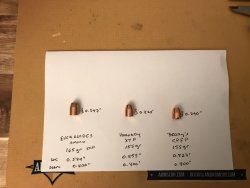I recently received a new .40 S&W projectile from Everglades Ammo, a 165gr JHP. I’ve been really happy with their JHP projectiles for .380 ACP and 9mm Luger, so I was really anxious to test these 165gr JHP in my new Springfield EMP 40.
I’ve run a number of powders under my standard Berry’s 155gr CPFN projectiles, and they run great, as well as 4 different brands and weights of factory ammo.
As with many alternate projectile manufacturers, there is no published load data for Everglades Ammo, so I went with that most dangerous practice...I “assumed“ they were the same as Hornady’s XTPs. Hey, the pictures looked similar.
I selected VV 3N37 for this load, and some once fired R-P cases. Vihtavuori starting load for 165gr projectile is 7.3gr, but I went with 7.0gr to produce a softer load this first time out. I paired this with CCI 500 SPP and seated to 1.125” C.O.L., pretty standard fare for .40 S&W. I always plunk test new ammo in my barrel to ensure that it is loaded off the lands. These rounds plunked fine, so I loaded up 9 more to test at my first opportunity, which came this past Saturday.
As to shooting, they were suitably soft...probably softer than I care for, but they ran Straight and true to point of aim. I was very pleased with their overall performance. However, I could only load 4 rounds at a time. At the 5th round, the follower would not rise up, and the 5th round basically flopped around. Four were fine, a fifth was a no-go. Both magazines.
Okay, not cool, but my main purpose is to test these loads. As I said, they shot just fine.
I mentioned in another thread that I would try again at 1.200”...from my tested 1.250”...and TexasforLife caught my typo. He didn’t know it was a typo, but nonetheless, I’m grateful he took the time to comment on my posted data.
So where is this thread going? I made an assumption that because a picture of a bullet looked similar to another that I could run with that assumption and produce loads for my precious Springfield EMP. In the memorable words of Bugs Bunny...”What a maroon!”
Key learning here for me...if two projectiles have the same diameter, and the same basic design, but one weighs 10gr more than the other...the additional weight has to go somewhere...and that usually means UP. A 165gr JHP should be longer than a 155gr JHP in the same caliber...if they are both lead cores with copper jackets.
The attached picture is a simple comparison of the 3 different .40 S&W projectiles on my shelf. I added a few measurements pic to show just how different these 3 bullets actually are. Different lengths, different profiles, different distance to start of ogive - all reasons why swapping projectiles in a load requires a whole new load work up to ensure function, and most importantly, safety.
I hope that this information is helpful to someone else as we continue this journey together.
I’ve run a number of powders under my standard Berry’s 155gr CPFN projectiles, and they run great, as well as 4 different brands and weights of factory ammo.
As with many alternate projectile manufacturers, there is no published load data for Everglades Ammo, so I went with that most dangerous practice...I “assumed“ they were the same as Hornady’s XTPs. Hey, the pictures looked similar.
I selected VV 3N37 for this load, and some once fired R-P cases. Vihtavuori starting load for 165gr projectile is 7.3gr, but I went with 7.0gr to produce a softer load this first time out. I paired this with CCI 500 SPP and seated to 1.125” C.O.L., pretty standard fare for .40 S&W. I always plunk test new ammo in my barrel to ensure that it is loaded off the lands. These rounds plunked fine, so I loaded up 9 more to test at my first opportunity, which came this past Saturday.
As to shooting, they were suitably soft...probably softer than I care for, but they ran Straight and true to point of aim. I was very pleased with their overall performance. However, I could only load 4 rounds at a time. At the 5th round, the follower would not rise up, and the 5th round basically flopped around. Four were fine, a fifth was a no-go. Both magazines.
Okay, not cool, but my main purpose is to test these loads. As I said, they shot just fine.
I mentioned in another thread that I would try again at 1.200”...from my tested 1.250”...and TexasforLife caught my typo. He didn’t know it was a typo, but nonetheless, I’m grateful he took the time to comment on my posted data.
So where is this thread going? I made an assumption that because a picture of a bullet looked similar to another that I could run with that assumption and produce loads for my precious Springfield EMP. In the memorable words of Bugs Bunny...”What a maroon!”
Key learning here for me...if two projectiles have the same diameter, and the same basic design, but one weighs 10gr more than the other...the additional weight has to go somewhere...and that usually means UP. A 165gr JHP should be longer than a 155gr JHP in the same caliber...if they are both lead cores with copper jackets.
The attached picture is a simple comparison of the 3 different .40 S&W projectiles on my shelf. I added a few measurements pic to show just how different these 3 bullets actually are. Different lengths, different profiles, different distance to start of ogive - all reasons why swapping projectiles in a load requires a whole new load work up to ensure function, and most importantly, safety.
I hope that this information is helpful to someone else as we continue this journey together.

